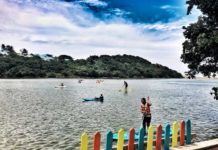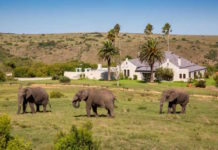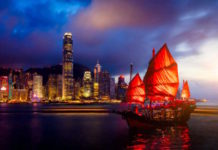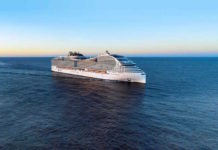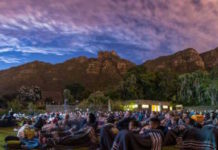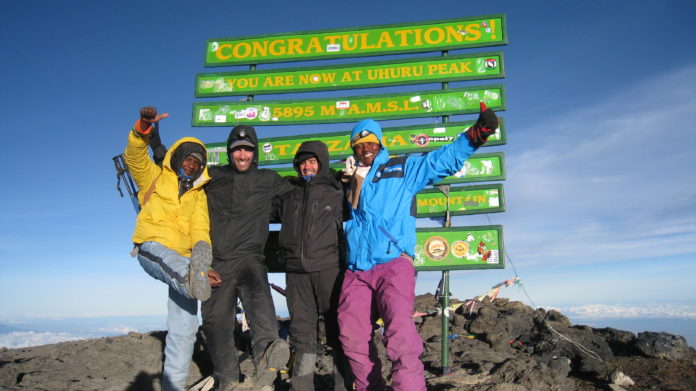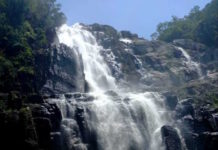If you’re someone with a keen taste for a mountain adventure, hiking Mount Kilimanjaro or the Everest Base Camp (EBC) trek are without a doubt on your bucket list. These are amongst the best mountain experiences in the world.
Choosing between the two might seem a little tricky though, especially if you aren’t an experienced hiker at high altitudes.
As someone who has had the privilege to complete both treks, I thought I would lay out the main differences to help you make up your mind.
Let’s go ahead and unpack these two breathtaking hikes.
Difficulty Level
Fitness is one of the first things a mountain hiker should take into consideration when planning a trip. Although both of these treks are amongst the most difficult in the world, they each require different types of physical endurance.
Based on my experiences, the big summit night of Mount Kilimanjaro is tougher than anything you’ll experience on the EBC trek. In addition, on Kilimanjaro, you’ll be faced with a big descent in a shorter space of time. This makes the trek more physically challenging, no matter how experienced or fit you are.
But with this said, it all depends on what you’re looking for.
While the summit day on Kili is more difficult, the two-week EBC trek requires a greater level of endurance. If you’re wanting longer distances as your challenge, then EBC is the trek for you.
Budgeting Your Trip
If budgeting costs is your biggest concern, then EBC is definitely your best option.
The cost of both treks will vary depending on which local operator you choose, but Kilimanjaro is significantly more expensive overall. I would say it’s around 2.5 times more expensive than the average EBC trek.
A trek up Kili will cost you roughly $2500. On top of this, you need to factor in another $1000 or so for international flights. You’ll also need to take other expenses into account, including gear, insurance, and tips for the support crew. Overall, you’ll be looking at around $4000 for a trek up Kili.
The EBC trek is significantly cheaper, despite it being a week longer than the average hike up Kilimanjaro.
Your cost for a trek up to the EBC will sit somewhere between $900 and $1200. This includes all your expenses including accommodation and support crew.
International flights to and from Kathmandu are generally a bit cheaper than flights to and from Kilimanjaro. You should plan to budget between $600 to $800 for EBC flights. The extra costs of gear, insurance, and support crew tips bring the total cost for an EBC trek to between $1800 to $2500.
It’s certainly possible to do both treks on a smaller budget, but this all depends on which operators you choose, how many people in your group (going solo is more expensive) and which comforts you’re willing to let go of.
Different Hiking Seasons
When to go is another big factor when planning a mountain trek. Both treks have different hiking seasons to take note of.
The best time to trek to EBC is either from March to May or from September through to October. The September season is most popular, so there is always lots of activity along the route during this time. I personally prefer April or May as this period coincides with the Mount Everest climbing season, so there is a lot of summit buzz and activity at EBC and along the trail.
Nepal’s rain season is between June and August. I would recommend avoiding this period for an EBC trek.
On the other hand, Kilimanjaro has a much longer hiking season. The best time for a Kili trek is from June through to October. There is another shorter season between January and March. These months are quieter, which is great if you are looking to avoid crowds, but the summit and higher reaches of the mountain are a little colder.
It is best to avoid April and May as this is when Kilimanjaro enters its rainy season.
The Length of Your Trip
The EBC trek is roughly two weeks long, while the average Kilimanjaro trek takes half as long.
Between work and family life, finding two weeks to take off is not really an option for most people. This is why Kilimanjaro is a more popular choice if you have limited time.
The EBC trek (5,364m), although lower in altitude than Kilimanjaro (5,895m), has a longer duration because the route profile to EBC is very gradual. Unlike Kilimanjaro, which has a relatively rapid ascent and descent profile, on EBC you need to give your body more time to acclimate.
Acclimatization
The ‘unknown’ of hiking at high altitudes is a common fear amongst first-time trekkers. This is definitely something to prepare for on a trip up Kilimanjaro or to EBC.
In my opinion, the high altitude on the EBC trek tends to be more demanding on the body.
The EBC hike has a more gradual elevation, but your descents take longer than on Kilimanjaro. If you ascend too rapidly on the EBC trail, you are more at risk of altitude sickness without being able to make a quick descent. Helicopter rescues are common on the EBC trek, but unheard of on Kilimanjaro.
Although altitude sickness is very common on Kilimanjaro, most people can be rushed down the mountain within a few hours and will start feeling better once at a lower altitude. Unfortunately, some people perish on the mountain due to severe altitude sickness.
Mountain Scenery
When it comes to scenery, I have to say that nothing quite rivals the unique beauty of the Himalayas.
After you cross Namche Bazaar, the iconic Himalayan peaks are magnificent to witness. In a region that boasts thousands of mountain peaks, you’re in for some breath-taking scenes.
What makes Kilimanjaro special is its distinct eco-zones. From the beautiful rainforests to the moorland zone, each different ecosystem feels like a whole new world. My most memorable morning on Kili was watching the sunrise over the ice fields from the summit.
If I had to choose though, I would say the EBC trek was my favourite when it comes to scenery.
The Trekking Experience
Both the Kilimanjaro and EBC hike brings a sense of achievement quite unlike anything else.
Standing on the Roof of Africa at EBC is truly an incredible experience. But I have to say that nothing rivals the feeling of accomplishment after reaching the summit of Kilimanjaro.
The summit will push you further out of your comfort zone, making the satisfaction even sweeter
Other Activities
Another factor to consider when choosing between the two treks is what you plan to do before or after your trek.
If you visit Tanzania, you have some of the best wildlife safari parks and tropical beaches in Zanzibar to visit.
While Nepal has the Chitwan Jungle Safari to offer, its biggest attraction is culture. The Everest tea house experience is amazing. You have the option to explore quaint villages as you make your way through the Khumbu valley, and once back in Kathmandu there are lots of city attractions to take in. Thamel, the tourist district of Kathmandu, provides a true assault on the senses and is very memorable.
This incredible insight into the local culture of Nepal is one of the biggest advantages that the EBC trek has over the Kilimanjaro hike.
Final Thoughts
With that said, it all comes down to what you want out of your trip.
Different hikers will have different preferences when it comes to choosing between the two. Both hikes are spectacular, and a definite must for any avid trekker out there
No matter which trek you go for, the main goal is to commit to the hike and enjoy the exciting adventure!
Bio: Mark Whitman is a travel blogger. He runs the web’s most popular blog on climbing Mount Kilimanjaro. Mark has hiked some of the best trails in the World, including famous hikes in the Himalayas, Andes and the Alps.
Gravatar email: [email protected]


